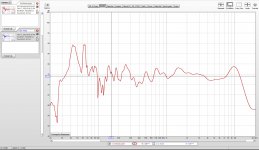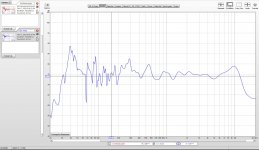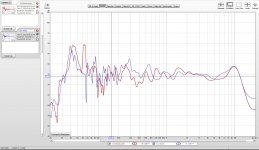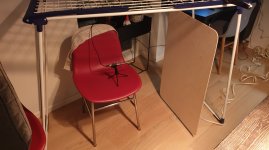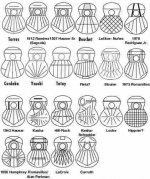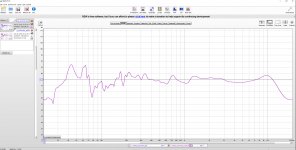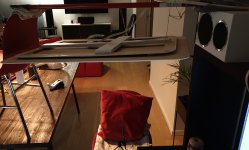I finally got a moment and got my Umik1 up and running.
I tested my very simple panel with no frame against the same panel with my prototype frame (not edge mounted).
I preferred the simple panel with no frame from my last comparison listening session, but now have some measurements to back that up with.
I found that a tall drying rack is an excellent testbed for horizontal panels.
Red is the framed horizontally mounted and blue is unframed hanging vertical.
No EQ has been applied.
I tested my very simple panel with no frame against the same panel with my prototype frame (not edge mounted).
I preferred the simple panel with no frame from my last comparison listening session, but now have some measurements to back that up with.
I found that a tall drying rack is an excellent testbed for horizontal panels.
Red is the framed horizontally mounted and blue is unframed hanging vertical.
No EQ has been applied.
Attachments
Found this after reading nesha's post:
Double top construction
Quote:
Water based glues cannot be used, as they would cause the thin skins of wood to curl like a potato chip instantly. Epoxy or polyurethane are the glues of choice here.
That was exactly my problem. Don't know why I didn't try epoxy.
Eric
Double top construction
Quote:
Water based glues cannot be used, as they would cause the thin skins of wood to curl like a potato chip instantly. Epoxy or polyurethane are the glues of choice here.
That was exactly my problem. Don't know why I didn't try epoxy.
Eric
Just Google it, top quality concert grade instruments, usualy very expensive guitars are doubletop designs. But I am not aware of any factory made panels... only luthiers make it for guitars...
Good panel probably would be double top classical guitar board - nomex honeycomb sandwiched between two thin sheets of solid spruce or cedar. Doubletop guitars play louder...
The solid sheet of spruce or cedar looks to be thicker then the Nomex honeycomb. If the skin is too stiff the Nomex honeycomb wont bend as easily therefore less bass.
So Burnt which type of panel design to you prefer better?
Free floating or Frame and spline?
Great question DMLBES. Currently I get good sound from both so I am agnostic. It’s a question I hope to bed down over time as I experiment more.
Great question DMLBES. Currently I get good sound from both so I am agnostic. It’s a question I hope to bed down over time as I experiment more.
Oh one last important question. On your panels that went down to 40hz was this with or without a spine? A spine can make a difference in bass output because it gives the magnet something to push off of transferring all of its vibrational energies into the panel. Without a spine some of vibrational energies is wasted because the magnet will move since there is nothing bracing it so less vibrational energy equals less bass. At higher volumes with music with a lot of bass the magnet will rattle if nothing is bracing it causing distortion that you can actually hear.
Last edited:
Others my disagree, but my suggestion would be to use a conventional subwoofer and use the panels for, say 150 Hz and above.
Endorse. Use DMLs for frequencies above the Schroeder small room transition frequency. Below that, use whatever you want.
The Schroeder Frequency: A Show and Tell, Part 1 | Sound & Vision
The solid sheet of spruce or cedar looks to be thicker then the Nomex honeycomb. If the skin is too stiff the Nomex honeycomb wont bend as easily therefore less bass.
Luthiers have spruce sheets thined to 1mm ... or less... by sanding, I think.
Oh one last important question. On your panels that went down to 40hz was this with or without a spine? A spine can make a difference in bass output because it gives the magnet something to push off of transferring all of its vibrational energies into the panel. Without a spine some of vibrational energies is wasted because the magnet will move since there is nothing bracing it so less vibrational energy equals less bass. At higher volumes with music with a lot of bass the magnet will rattle if nothing is bracing it causing distortion that you can actually hear.
The frames were with spines. I think that is a sound principle if you are going for bass on a floor standing DML.
The frames were with spines. I think that is a sound principle if you are going for bass on a floor standing DML.
What I was asking was if the spline made a difference in (40hz) bass response as opposed to your free floating panels without a spline.
From my experience when I did a A/B comparison of my sub panels (23heightX15inch width) one with a spline and one without the one with a spline bass response is more pronounced with higher spl levels even at lower frequencies. Plus the sub panel with the spline has no rattle from the magnet. The sub panel without a spline the rattle is significantly noticeable. Do you not hear the rattle from your panels without a spline?
I haven't built my larger panels yet as I don't really have the need to as my smaller panels with the DML sub are very satisfying.
I am still contemplating about the width though as I don't want to cut them to 12inches and find out later that 15inches and up produces more/lower bass. Like I said before my 23inch height X 15inch panels can reach 50hz at adequate volume levels and it does 60hz with authority.
I just want to make sure that it was the shape that changed the lower bass and not from any other factors like using a spline, frame, foam. I've paid around $185.00 for these large high density EPS sheets so every sheet has to count. I also spent around $50.00 on Frost King foam recently. This hobby is getting frickin expensive. lol
Then again I have to take into account that we are using two different types of materials so we could get different results. EPS bends more easier then wood and wood is stiffer then EPS.
I played that Grace Jones track on my panels and it sounded phenomenal.
I misunderstood your question DMLBES, sorry, its late here. I thought you were asking if the use of a spine extended the response, which you were clearly not.
My experience maps to yours on spines but with the following caveat. I find splines introduce their own problems. They put energy into the frame and this can be heard. Unless you have a soft material in contact with the exciter the exciter can 'buzz' the spine etc. If I am using my panels from 100 Hz prefer to do without. I have experienced no excursion problems from the exciters above 100Hz.
The rattling of the exciter with lower frequencies is just a matter of amplitude excursion rather than frequency so if you increase the number of panels, for any given frequency you can reduce the excursion per exciter and avoid the dreaded exciter rattle. Where floor space is at a premium you can mount a second set of panels at right angle to the front facing ones. I have done this with ESL's in the past and with DML's being bipolar its even simpler. For a hanging arrangement you can increase this to four or even eight panels per side which will reduce the amplitude/ excursion by a factor of four or eight. It obviously demands a lot of wall area and more exciters but they are cheap, as is the panel material, so really WAF i the biggest obstacle to experimenting with this. When I am back in France I am going to give this a try.
My experience maps to yours on spines but with the following caveat. I find splines introduce their own problems. They put energy into the frame and this can be heard. Unless you have a soft material in contact with the exciter the exciter can 'buzz' the spine etc. If I am using my panels from 100 Hz prefer to do without. I have experienced no excursion problems from the exciters above 100Hz.
The rattling of the exciter with lower frequencies is just a matter of amplitude excursion rather than frequency so if you increase the number of panels, for any given frequency you can reduce the excursion per exciter and avoid the dreaded exciter rattle. Where floor space is at a premium you can mount a second set of panels at right angle to the front facing ones. I have done this with ESL's in the past and with DML's being bipolar its even simpler. For a hanging arrangement you can increase this to four or even eight panels per side which will reduce the amplitude/ excursion by a factor of four or eight. It obviously demands a lot of wall area and more exciters but they are cheap, as is the panel material, so really WAF i the biggest obstacle to experimenting with this. When I am back in France I am going to give this a try.
Just to add that this panel approach is no different to using multiple exciters like the Podium design except that there is a single exciter to each panel which seems to give the best sound. It's a bit excessive, but might be a way to have your cake and eat it, a current British obsession.
Yes its getting more expensive, but I think Grace is worth it..
Now it is super late and I have to go to sleep.
Cheers
Burnt
Yes its getting more expensive, but I think Grace is worth it..
Now it is super late and I have to go to sleep.
Cheers
Burnt
Last edited:
I'm looking for some plywood board REW measurements to compare to.
Does anyone here have any? I've done mine around 75db from 20-20.000hz.
I'm trying to manage where my expectations should be in terms of low frequency control and output and where to cross over on my 60cm x 90cm 5mm thick birch ply panels.
Right now i'm getting a nice mid-range and a high frequency that I can manage with EQ, but up to about 200hz the curves are not pretty.
I'd like to cross over closer to 80, but I'm concerned that will not be feasible.
I'm still fiddling with designs to improve the low end, and while my first framed mount (mounted 2 inches from the edge) was not great, i'm still considering an iteration of this, as they seemed to implement better control in the lower frequencies.
Also, i've tried mounting them with strings both vertically and horizontally, and this unsurprisingly only works well vertically, which is not how I intend to apply these panels.
My next attempt is to reduce the amount of rubber on the frame to limit the over dampening I was getting from my poor frame placement, as was mentioned here, about 60% on the long edge and 75% on the short.
If this doesnt yeld any improvements, I'll be doing a frame closer to the edge and compromise the WAF!
Does anyone here have any? I've done mine around 75db from 20-20.000hz.
I'm trying to manage where my expectations should be in terms of low frequency control and output and where to cross over on my 60cm x 90cm 5mm thick birch ply panels.
Right now i'm getting a nice mid-range and a high frequency that I can manage with EQ, but up to about 200hz the curves are not pretty.
I'd like to cross over closer to 80, but I'm concerned that will not be feasible.
I'm still fiddling with designs to improve the low end, and while my first framed mount (mounted 2 inches from the edge) was not great, i'm still considering an iteration of this, as they seemed to implement better control in the lower frequencies.
Also, i've tried mounting them with strings both vertically and horizontally, and this unsurprisingly only works well vertically, which is not how I intend to apply these panels.
My next attempt is to reduce the amount of rubber on the frame to limit the over dampening I was getting from my poor frame placement, as was mentioned here, about 60% on the long edge and 75% on the short.
If this doesnt yeld any improvements, I'll be doing a frame closer to the edge and compromise the WAF!
Last edited:
I'm looking for some plywood board REW measurements to compare to.
Does anyone here have any?
kaptajn,
If you look back to post 848 in this thread you can see my REW result with approx 5 mm plywood. Its construction is described in post 838, and there are some images in post 839, 842 and 843.
I can't say for sure but I think the result shown was with EQ, mostly knocking down the peak at around 450 Hz as I recall.
I have to say I thought your results looked pretty good. I was surprised that strings (vertical) worked as well as they seem to have for you. When I use strings alone or other minimal supports I typically get characteristic sharp dip/low plateau/sharp spike effect in the 100 to 150 Hz region.
I was pretty impressed with how low yours go. Mine drop off quickly below 70 Hz. I've tried up to 24" x 48" and even that did not give me more low frequency output.
What happened with the horizontal panel and vertical strings? I was skeptical it would work mainly because the strings would be going slack whenever the panel flexed up, then suddenly go taught when it flexed back down. Doesn't seem ideal, but that may or may not be the issue you faced.
My own experience suggests that putting the foam closer to the edge of the panel will do more for you than anything else. But I'm finding myself surprised pretty often with these speakers, so try your WAF friendly ideas first and see what happens!
Eric
Last edited:
Right now i'm getting a nice mid-range and a high frequency that I can manage with EQ, but up to about 200hz the curves are not pretty.
It's not unusual for DMLs that the the low frequency is bumpier than high frequency. The reason frequently cited for this is that the density of modal vibrations of a panel is much greater at high frequencies than it is at low frequencies.
But I wonder if something else isn't influencing your observation. I noticed that in your REW plots you applied VAR smoothing. That's actually a choice I've never even noticed before. But it apparently applies less smoothing at low frequencies than at high frequencies. Of course, there is no "right" or wrong smoothing, but some make more or less sense depending on your objective. I tend to use Psychoacoustic smoothing most of the time, because it supposedly most closely mimics how our brains process sound.
Maybe you chose VAR purposely, but in case you did't, I wanted to call it to your attention.
It's not unusual for DMLs that the the low frequency is bumpier than high frequency..
Thanks for the reference to your build, I remember seeing it a while back when i was going through the whole thread and thinking it was a very nice solution.
I went ahead and removed the rubber from the corners, it's now roughly 60% on the long side and 70% on the short.
This made quite a big impact, and I feel like the lower range also went into EQ-able territory and it's generally flatter then I expected.
It's still a little more lower in output then the free hanging one, but It can still play louder then I need it to, it will just need a bit of a volume boost along with the EQ on my receiver.
I'm using Var smoothing because I picked that up from a youtube video (6 minutes in):
YouTube
Apparently he is claiming the same thing as you 🙂
I saw another video that I cant find right now which claimed that var-smoothing was more correct when creating a correction curve for DSP. I honestly don't know which are accurate, but I got used to seeing this graph now and got a feel for it.
Graph is the measurement without EQ.
Picture with the framed panel is the result of the attached graph.
Picture with the stringed up horizontal panel was not great, as previously mentioned.
Attachments
- Home
- Loudspeakers
- Full Range
- A Study of DMLs as a Full Range Speaker
